27 Gennaio 2014
English
Stone interiors for the contemporary retail.
AquiliAlberg Studio signs Philipp Plein boutiques
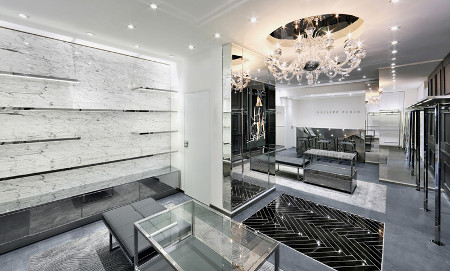
AquiliAlberg Architecture and Design Studio, interiors of Philipp Plein boutique in Porto Cervo, 2013 (supply and manufacturing of the stone: Pibamarmi).
From high-circulation periodicals to television news, from the most specific strategies of the luxury brands to the massive advertising campaigns, third-millennium communication is referring with more and more frequency to the themes of physical and psychical well-being.
In this way products and practises devoted to body and mind care become distinctive marks of a new organicism redesigning sensorial and emotional experiences of the subject. The commercial universe of apparel, jewellery, homeware, cosmetics and wellness turns into an essential step to reach physical and mental individual fulfilment; following sophisticated lifestyle as well becomes symbol of self-confidence and self-affirmation derived from gained or desired economical satisfaction.
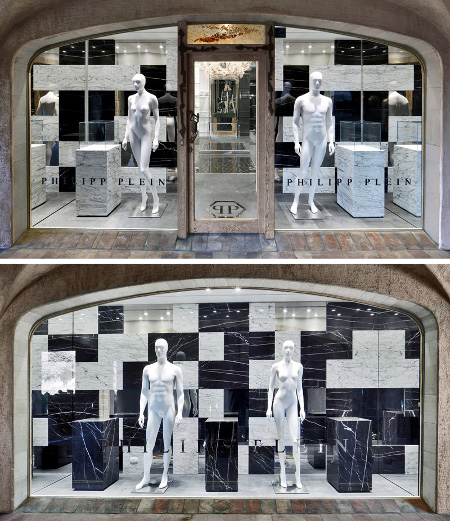
AquiliAlberg Architecture and Design Studio, windows of Philipp Plein boutique in Porto Cervo, 2013 (supply and manufacturing of the stone: Pibamarmi).
In such a scenario, stone materials, for their intrinsic sensorial and cultural values, are shown a renovated interest on global scale and are chosen for the interiors of spaces to which contemporary society gives a particular functional and symbolic meaning. If stones and marbles have historically materialized the idea of long-lasting quality, prestige and wealth, nowadays, in a new luxury conception based on stimulation of the senses, the axiom is shifted to naturality exalted by creativity and technology.
Places and precious objects made of stone should in the third millennium convey the idea of a close approach to the most intimate desires of the buyer, they should in other words satisfy the subjects in terms of perception and introspection.
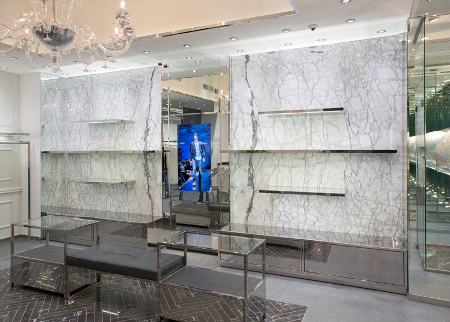
AquiliAlberg Architecture and Design Studio, arabesque marble wall of Philipp Plein boutique in Kiev, 2013 (supply and manufacturing of the stone: Pibamarmi).
Several projects in the domain of high-level hotelery are moving towards this direction and they are based on an idea of hospitality developed in recent years, with the continuous expansion of shared spaces – the traditional ones as the reception, the waiting room, the café and the restaurant, but also new kinds as spas, fitness and beauty centres, meditation and meeting rooms, shopping galleries, exhibition halls for cultural or social events, food plazas, and lounge bars. In this expansion and mutation, hotels become “self-sufficient cities”, characterized by hybridization and multiplication of functions that develop and superimpose in the same structure and at the same time.
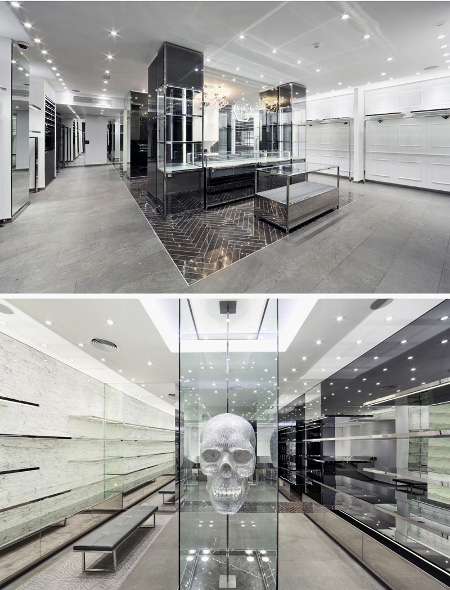
AquiliAlberg Architecture and Design Studio, interni della boutique Philipp Plein a Barcellona, 2013 (forniture e lavorazioni lapidee Pibamarmi).
A similar syncretic functional phenomenon is characterizing nowadays the commercial spaces of exclusive brands as well, spread throughout the world in more or less expanded chains. The aim of projecting shops has always been to attract consumers and to build a convincing and alluring representation of the products on sale. In the new forms and in the new places of the contemporary living, these projects go beyond the limits of traditional shopping, in order to make the customer not only appreciate the brand qualities but also identify with them, with the atmospheres, experiences and lifestyles connected to producing, buying and using those same products or services.
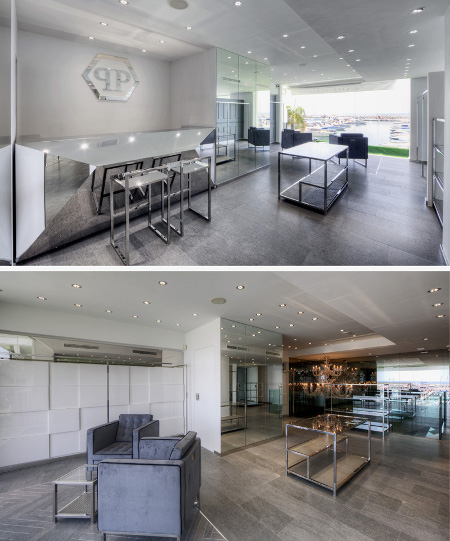
AquiliAlberg Architecture and Design Studio, panoramic lounge space of Philipp Plein boutique in Marbella, 2013 (supply and manufacturing of the stone: Pibamarmi).
In flagship or concept stores, architecture and design transmit captivating and convincing messages related to the brand, they speak a strong language able to attract and guide the attention of the consumers, to create with them an expectation linked to the curiosity to discover and interiorize the brand values; in the end, more comfortable spaces are offered to make the customers feel at ease in the moment of the purchase. The commercial space as well turns into a complex and articulated multifunctional holder, not only a destination where you buy something but also a place where you can be protagonist of an exclusive experience linked to the brand identity.
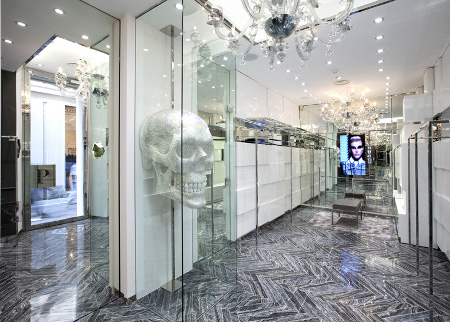
AquiliAlberg Architecture and Design Studio, interiors of Philipp Plein boutique in Milano, 2012-13 (supply and manufacturing of the stone: Pibamarmi).
In the typological transformation of functions and aesthetics of interior design for the contemporary retail spaces, stone covers a strategic role showing a double identity: it is characterized by both a traditional solidity in its material structure, and a flexibility open to applicative polymorphism and contaminations created with innovative technologies of digital projecting and computerized production. It is the case of the Philipp Plein boutiques recently signed by AquiliAlberg Studio, in which precious and attractive stone materials are used as main presence or in balanced association with crystal and chrome metals.
The setting in the stores of the Swiss brand underlines floors and coverings made of stones and marbles that have been polished or coated; stone materials can be appreciated through sight and touch and they are present in black, white or scale of greys, and with plain, veined or arabesque-like textures. Composition of the boiserie and of exhibition walls are hallmarked by horizontal linear geometries conveying the concept of an elegant and sumptuous luxury, based on the naturality of stone that is punctuated with neo-decorative elements in glitter or glass linked to the brand visual identity.
